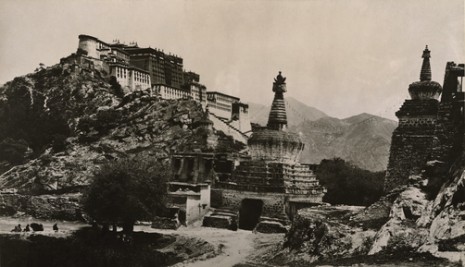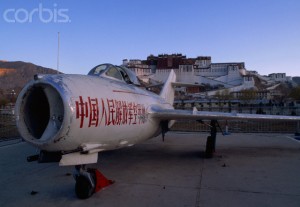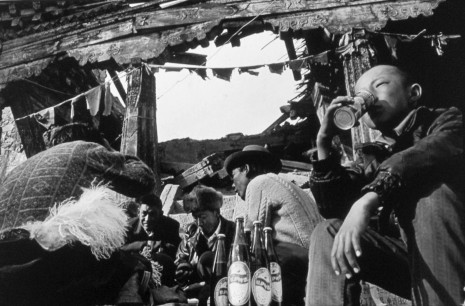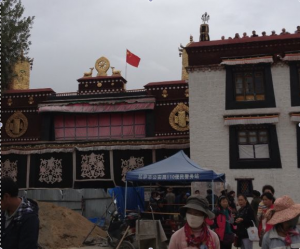The next phase of Communist China’s destruction of Lhasa came innocuously enough with Deng Xiaoping’s “Liberalization”, starting from the turn of the eighties. In the groundbreaking cartographic study published by the Amnye Machen Institute, Map and Index of Lhasa City by Christophe Besuchet, a more specific time period is provided in the introduction. “The process of destroying Lhasa as a Tibetan city is fairly recent. It began in a systematic way in 1984 with the demolition of the old historic buildings overlooking the entrance of the Jokang and later demolition of a number of old buildings surrounding the Jokang, for the creation of large public-square.”
Around this time the Drago Kani, the three gateway stupas of Lhasa, which were damaged in 1959, were completely razed, and concrete replicas put up in their place. I was told that the required consecration rituals were not performed in their construction, making these structures about as spiritually vital as the Golden Arches over a McDonald’s.

In the old days the crest of the three stupas were joined together by a long string of wind-chimes whose melody welcomed the visitor to Lhasa. This desecration of Lhasa’s spiritual gateway inspired what might be called the first major protest song in the Tibetan freedom movement. The lyrics by an anonymous songwriter subtly expressed the popular yearning for the Lhasa of old.
In front of the Potala Palace were the three beloved stupas
When the breeze stirred the wind-chimes
What resounding music could be heard,
How melodious they once sounded.
Aaah, stupa Drago Kani, I suddenly remember you in my heart.
.

The song became hugely popular throughout the plateau when it was sung by the famous Tibetan singing star, Dadon, who had earlier won the top prize in China’s National Song Competition. The success of the “Gateway to Lhasa” and a couple other songs expressing “local nationalism” might have gotten her into the PSB’s bad books. She fled Tibet in 1992 and now lives in New Haven Connecticut. I have a copy of this song covered by the Paris based musician, Tenzin Gompo la. If anyone has Dadon la’s original I would be grateful for a copy.
Next came the destruction of the ancient Zhol hamlet directly below the Potala and the eviction and relocation of all its residents. Also bulldozed out of existence was the charming old Shukti Linga, the Throne Park, in front of the Potala Palace, which in the past was encircled by a forest that even sheltered a small herd of deer.
In its place we now have a hideous concrete-paved square used for the sort of mass events and military parades beloved of totalitarian regimes. To this defilement has been added a couple of tacky concrete ponds with islands, to the east of the square, one topped with a stereotypical “oriental” pagoda. These ponds might be described as more ambitious versions of those ubiquitous plastic ponds that grace the foyers of all Chinese buffets in North America.
 The square also has an old MIG 15 aircraft parked in it, possibly for the amusement of the tourists that were expected to come to Lhasa in droves. In 2002, the southern end of the square was graced with a giant “artillery-shell shaped” (according to Woeser) monument, to the “Peaceful Liberation of Tibet”. The latest addition in the square, for the entertainment of Chinese tourists, is a musical fountain system with colored lights that flash in time to the beat of amplified Chinese pop music. Chinese tourists have now taken over Lhasa in an overwhelming way, and even appear to outnumber the natives, especially pilgrims from Kham and Amdo. These visitors are becoming rarities, as travel permits to Lhasa are being increasingly restricted for Tibetans from those regions.
The square also has an old MIG 15 aircraft parked in it, possibly for the amusement of the tourists that were expected to come to Lhasa in droves. In 2002, the southern end of the square was graced with a giant “artillery-shell shaped” (according to Woeser) monument, to the “Peaceful Liberation of Tibet”. The latest addition in the square, for the entertainment of Chinese tourists, is a musical fountain system with colored lights that flash in time to the beat of amplified Chinese pop music. Chinese tourists have now taken over Lhasa in an overwhelming way, and even appear to outnumber the natives, especially pilgrims from Kham and Amdo. These visitors are becoming rarities, as travel permits to Lhasa are being increasingly restricted for Tibetans from those regions.
But the first wave of tourists to Lhasa came largely from the West, which in turn prompted an unprecedented influx of Chinese traders, merchants and migrant labor into Lhasa. Even back then in the “optimistic” eighties it was possible to detect signs of a possible “beginning-of-the-end” scenario for Tibetan survival. I wrote a fairly depressing two-part article on this for the Tibetan Review : “Chinese carpenters, masons, tailors, smiths, petty traders, restaurateurs, truck drivers, teachers, electricians, mechanics, barbers, butchers, guides, laborers, street entertainers, beggars and, of course, the myriad ubiquitous functionaries so indispensable to the proper functioning of a totalitarian state, are relentlessly pushing the Tibetan into immediate unemployment and ultimate extinction.” (“On the Brink”, 1986)
I described the ubiquitous alcoholism that was then taking hold of Lhasa, fuelled by the sale of cheap beer (pijiu) and the even cheaper Chinese rot-gut, baijiu and sanjiu, and how this alcoholism was becoming “one of the most severe problems in Tibet, a fact to which the many broken bottles littering the streets of the Tibetan section of Lhasa city will bear partial testimony.”

.
According to a TIN Briefing Paper #31 (Social Evils: Prostitution and Pornography in Lhasa) one of the root causes of alcoholism in Lhasa was the proliferation of an astonishing number of bars and discos in the city, and that “.. people feel attracted to these places and start drinking there. At night there are many fights on the street. Many schoolchildren spend their evenings in bars.” The report discusses the social problems created by this alcoholism: increase in divorce rates, broken families, domestic violence and abuse, and the problem of pregnant women alcoholics. A Tibetan medical personnel from Lhasa who I met in 2007, told me she had observed symptoms of fetal alcohol syndrome in some new-born babies in the Holy city.
The Chinese authorities appear to actively encourage the sale, distribution and consumption of cheap alcohol. There also seems to be no stringent regulation regarding sale of alcohol to minors, or the kind of alcohol licensing laws that you have, let us say, in India or even in the USA to discourage underage drinking or excessive drinking. In a post-totalitarian state where you have some of the most draconian (and effectively enforced) state regulations restricting freedom of expression and freedom of worship, the only freedom that the citizens of Lhasa, adults or children, have, is the absolute unregulated freedom to drink themselves to death anytime, anywhere.
In 1985, alcohol consumption in the Tibet Autonomous Region had already reached fifteen times the average alcohol consumption in China, according to the 1990 China Statistical Yearbook.
TIN Briefing Paper #31 also addresses another social evil plaguing “brave new” Lhasa. This report cites an unofficial survey conducted in 1998 “which showed 685 brothels and 238 dance halls and karaoke bars in 18 main streets of Lhasa.” The report notes that for a city with a population of 200,000, the figure represents an extremely high density, and one that is likely to be higher since it is only calculated on the basis of 18 streets rather than the whole city. Most of the prostitutes in Lhasa are Chinese girls “who appear to originate from Chengdu and farming areas in Sichuan.” The report concludes: “A conservative estimate of the total number of brothels where prostitutes can ply their trade in Lhasa municipality is approximately 1,000.” This figure is for brothels exclusively and does not include bars, clubs and restaurants, where prostitutes openly offer their services on the premises, many of which have back rooms where they can take their clients.
In the relatively “liberal” climate of the eighties the Panchen Lama assembled a team of Chinese and Tibetan architects to document the architecture of the Potala and some other major monasteries. In 1985 a Tibetan archeologist, Sonam Wangdu la, started a project to compile documentation of the most important surviving historic buildings in Lhasa and even throughout Tibet. This resulted in a report, County Cultural Relics Series that methodically documented the destruction of Tibet’s historic and religious buildings and sites. The report concluded that only a small handful of such structures and sites had escaped substantial damage.
Large-scale “repairs’ of the Potala were officially undertaken in 1988. In 1994 the Chinese announced, with much fanfare, the completion of the repair works. Many in Lhasa privately expressed doubts about the quality of the work done. One of the oldest chapels in the palace, the Avalokiteshvara chapel (Chenrezig Lhakhang) is said to have been destroyed because of carelessness and insufficient grasp of modern restoration methods by Chinese technicians and officials. Amnye Machen Institute (AMI) obtained a photograph of what was probably this chamber entirely in ruins. A number of murals were reported to have been irreparably damaged then. Many in Lhasa believed that the restorations were a pretext for the Chinese to carry off many of the vast treasures of the palace. A political prisoner from Lhasa, Tenpa Phulchung, has in his memoirs written of the destruction of the Potala that took place in the name of reconstruction.
In 1996, with the encouragement of the Lhasa municipality and with the participation of Western experts, the Tibet Heritage Fund was created for the protection and restoration of historic buildings. This effort received much financial support from Western donors as Trace Foundation, Heinrich Boll Foundation, MISEREOR, Rubin Foundation and others. In 1994, UNESCO placed the Potala Palace on the World Heritage List. In 2000 and 2001 UNESCO listed the Jokhang and the Norbulingka on the World Heritage List as extensions of the Potala, making Lhasa, already a sacred place in terms of its value for religion, history and the humanities, a part of the world’s cultural heritage. 93 buildings in Lhasa were listed as protected sites and marked with a blue identification plaque. There was a tremendous feeling of optimism among Western Tibet supporters.
Not everyone in Lhasa was completely at ease with this new development, especially as the official Lhasa City Cultural Relics Bureau was involved in this project. This was a branch office of the Office of Cultural Relics Management Committee of TAR, located at the Norbulingka palace, which had been primarily responsible for removing arts treasures from Tibetan monasteries and temples and shipping them of to China.
All the Western experts, donors and even most of the Tibetans officials who participated in this project, had no doubt done so with the best of intentions. But their commitment and optimism were based on the assumption that the Chinese authorities shared their cultural and philanthropic concerns and would honor whatever agreements had been entered into to realize this important venture. One donor told that it was in China’s interests to preserve historic Lhasa, since, even if it didn’t care about Tibetan culture, it would help to promote Western tourism, which China surely wanted.
I did not share this optimism. AMI’s Map and Index of Lhasa City makes clear that “… in 1980 the Chinese authorities drew up plans for the redevelopment of Lhasa city. Ten Planning maps were drafted by the Lhasa Planning Bureau, which have been circulated for restricted viewing. In essence this plan calls for the complete destruction of all old building with the exception of the Potala Palace.” Even otherwise, if one just made the effort to look under the picturesque surface and color of tourist Tibet, one could not escape the disturbing evidence that Beijing had an actual plan to make Lhasa into a Chinese city, inhabited largely, or even near exclusively by Chinese immigrants. Of course, till the 1980s the Chinese authorities had been unable to do much to implement this plan as they did not have the foreign investment, even the long-distance public transport necessary, to attract Chinese immigration into Tibet.
But in research circles in exile, as early as the mid seventies, we heard of a Chinese master plan to build a railway to Lhasa to bring in Chinese settlers. Even when Tibet was an independent nation, the leader of Nationalist China, Dr Sun Yat-sen had in his 1917-20 proposal included a projected railway to Tibet. After the invasion in 1950, Chinese and Russian engineers were sent to investigate the possibility, but the lack of technological and financial resources prevented the project from even starting. Furthermore the construction of the Sichuan-Tibet and Qinghai-Tibet Highways took priority. But the railway project was never entirely forgotten. At one point, before a foot of track had been laid on Tibetan soil, a railway station was built, with a large signboard announcing the fact, in an isolated area between Drepung and Lhasa. An American academic who visited Tibet in the early eighties saw this surreal work of political symbolism. Then in 1984 the first section of the Qinghai-Tibet railway, between Xining and Golmud was completed.
2000-2012
From late 2000 onwards Chinese cooperation with the Lhasa Heritage Fund came to an end, and in the following years most Western experts and NGO’s were expelled from Tibet. During and after the 2008 protests you did not have a single Westerner, expert or tourist to witness the next phase in China’s destruction of Lhasa city.
In February 2012, I received this report from a Western visitor (one of the few that year) to Lhasa that I published on this blog.
Lhasa consists of approximately 1.2 million Chinese and approximately 200,000 Tibetans. The majority of these Tibetans live in an area which is now almost entirely enclosed by military compounds with walls between 10-16 feet; some with barbed wire. This isolation gives the impression of what the Warsaw Ghetto was like. Inside the “enclosed” area groups of armed soldiers, S.W.A.T. teams, and police patrol the streets 24 hours a day. Military drill songs can be heard throughout the day. S.W.A.T trucks and rows of 6 to 15 armored vehicles and tanks come through the area on a daily basis. Each vehicle has 3 to 4 soldiers at the opening turret, armed with assault rifles or machine guns aimed at the Tibetans.
All Tibetans must carry identification at all times. Tibetans residing in Lhasa are required to register with the police. There are approximately 134 new Police station checkpoints in Lhasa for random searches of pedestrians and vehicles. In addition to the military compounds in and around Lhasa, permanent military posts holding 1-10 armed soldiers have been established throughout the city. Roadside checkpoints in the Tibetan Autonomous Region are used to keep Tibetans that are not residents of Lhasa, away from the city.
Although it is listed as a World Heritage site, the Chinese government now uses the Potala as a military post. A large Military complex is situated within several blocks. The nunnery, located across from grounds before the Potala Palace, now has Military bunkers. Jokhang area has such a large military presence in that you have to be careful not to bump into soldiers and police when they go on patrol.
This writer was not a Tibet expert, and was just noting what she had seen and what some Tibetans in Lhasa had told her, and her report was understandably uneven and incomplete. A few Tibetans and even a Western supporter or two (on TSG List) cast doubts about its authenticity.
2013
But now Woser la’s recent blog post provides confirmation on the extreme security build up that has taken place in Lhasa over the last few years, especially in the old city. She also adds that snipers are now posted on the rooftops of the building in the Barkor area, particularly in front of the Jokang.
But her latest piece is not only about the security build-up but about the latest phase in the destruction of the Holy City. High Peaks Pure Earth has provided an English translation of her report which I am sure the reader has already scrutinized. They will also have seen all the stomach-churning photographs included in the report.

This time the destruction is taking place in the name of commercial development, with Five Star Hotels, Barkhor Shopping Malls, “Spiritual Power Plazas,” giant underground parking lots, flashy high-end art and antique boutiques, all of such overpowering vulgarity and invasiveness, that it makes Disneyland seem, at least in terms of aesthetic subtlety, like the famous Ryōan-ji Zen Garden in Kyoto. Nonetheless, a recent photograph by a Chinese tourist of the Communist flag flying over the Jokhang, amidst the clutter and mess of the present construction, should make us aware that what is happening in Lhasa is not just “the unfortunate but unavoidable by-product of globalization and progress” (as the convenient rationalization goes) but that hard political considerations still reign supreme, as they always have in China.
It goes without saying that the destruction of the old city also necessitates the removal of its original inhabitants. I mentioned in a couple of earlier posts how the constant harassment of Lhasa locals by Chinese security personnel has become so extreme that many Lhasa citizens are leaving their homes to live in the “relative” freedom of Chengdu and other Chinese cities. Even such collaborators as Samding Dorje Phagmo , who was a member of the Political Consultative Committee, has sold her house in Lhasa and left. One of the historic building near the Tsuklagkhang, the Tromsikhang Palace, which received the blue Heritage plaque, is now scheduled for a complete overhaul and the forty odd families that lived in this building complex have been removed and relocated outside Lhasa. Woser la writes that those Tibetans who were removed for the construction of the Barkhor Shopping Mall were relocated to a settlement in Tolung Dechen west of Lhasa. I have heard reports that many Lhasa residents of the old city are to be relocated to settlement colonies in Tsal Gungthang twenty kilometers east of Lhasa, where there is also a large military prison.
Woser la has done a tremendous job to publicize the destruction of Lhasa. She has managed to get the attention of numerous international and Chinese journals and websites, and even provoked the official People’s Daily enough for it to issue a detailed refutation. Articles have appeared in the South China Morning Post, Business Insider and in the Sunday Times of London largely quoting from her report. Because of her appeal a number of petition drives have been started. One petition signed by more than a hundred independent and institutionally-affiliated specialists in various fields of Tibetan Studies have expressed “grave concern over the rapidly-progressing destruction of much of the traditional architectural heritage of the Old City of Lhasa and its environs”. They have called on China’s president and UNESCO secretary general to to send independent investigation team as soon as possible to Lhasa. Woeser is also posting regular updates on her blogsite. I think it is vital for all of us to do what we can to raise this issue internationally, and bring as much pressure to bear on China to at least call a moratorium on the constructions in Lhasa.
And while Woeser la has managed to do so much, even under the constant surveillance of Chinese security, those of us exiles living in the freedom of democratic societies, have instead all been caught up in the pettiest of petty politics. The CTA has managed nothing more than its usual expression of “deep concern“, while Samdong Rinpoche’s religious-right zealots have been carrying out a nasty (and effective) campaign to demonize the Tibetan Youth Congress for “hurting the Dalai Lama’s feelings.” Everyone else has been too busy trying to avoid being labelled anti-Dalai Lama or pro-Rangzen, to spare even a moment’s consideration for Woser la’s appeal.
All the while, the holiest of cities, the seat of the gods, the Mecca of High Asia (Prezhevalsky), the Rome of Buddhism, (Bell, Lowell-Thomas, etc.) the capital of the ancient Tibetan Empire, and, for many of us, the secret city of our dreams, is fast disappearing in the dust and rubble of Chinese bulldozers.




Thank you Jamyang la for highlighting the ongoing destruction of the Lhasa and the historical inevitability of such an act, given the rule of tyranny and greed. It is quite remarkable that you always seem to keep the course no matter what kind of slander and other shameful and despicable accusations are labelled against you – some of them coming from monks recently like Jeshong Sangay Gyatso who really should be working on his spiritual development more so than actively engaging in slandering people. I couldnt’ understand why Phayul would even allow such a childish piece from a half-baked monk. that is not to say this site is not full of it but at least it is only in the comment section and with their predictable go to logic.
Well, keep up the good fight and keep educating the youth who will be less reliant on dogmatic and archaic brain circuitry and might actually think for themselves, instead of throwing up blinders everytime religion is thrown in the mix. There is a reason why you are who you are and why you are above a notch from the rest of these so called intellectuals. Ok,make that two notches. We are behind your heartfelt commitment and loyaty to Tibet and Tibetans. I salute you, sir!
I agree with mr gashi. Jamyang Norbu’s contribution has been enormous.His love of tibet shows in his degree of honesty reflected. Some don’ t like him because they believe hh is god and god can do no wrong. Some fear because his writing effectively exposes their dishonesty. Many love him because he makes no one has a monopoly on truth.
Who wouldn’t happily abandon their rights, religion, culture, language, and nation once they’ve beheld that spastic, manically brutal neon urine marking of a fountain?
I wish amdo gedun chophel is here today to read this piece of historical account. Thank you JN
Thanks Jamyang la for yet another great piece !
I have the Dadon’s song about the stupa and her another song called Lhasai Barkor which describes the old Barkor. If you would like to have them for your research, please contact me.
Thank you Jamyang-la. Great piece.
I was back in Hunsur in May 2013. I was forbidden from entering the Settlement Office complex because women are not permitted to enter the complex without Chupa. I didn’t bother twice for I had nothing that I needed from them.
Note the communist-like rigidity!
And discrimitation against women. Men can go in there without chupa!
I am not at all surprised with Hunsur RTYC chapter’s boycott of the TYC’s GBM. The place is literally a totalitarian society. I think no one dare oppose whoever is pulling strings of the settlement “leaders”.
What is being done to TYC is very disturbing.
To think that our “leaders” are coming down to this!!
TCL
Three prostrations to Jamyang Norbu la. As long as we have people like you who is so earnest, loyal and forthright towards the cause of Tibet, we Tibetans have some hope. What I love most about you is that you do all this on your own dime, your are a genuine Tibetan hero – a NORBU – and posterity should judge you most favourably.
Dear Jamyang la;
I would like to convey millions of thanks to you for presenting us such wonderful piece of articles that big fighters of middle way coveniors could not write . Your way of presentation Tibetan freedom struggle in terms of destruction of our historic heritage by Communist Chinese Govt as like more helpful than making hot seat in gangkyi without doing nothing except fooling the people.
Many fool fellows of Tibetan in diaspora may fail to recognise you
please forgive them they did not know politics of cta whose head is headed by Obarma of China having no credential of Harvard .
Thank you Jamyang la for being our teacher. You represent the only light of hope in this sea of darkness called faith-based politics.
If it was upto me I would allocate a major portion of DIIR budget to you, Woeser la and those who, despite enormous personal costs, continue to inform the public about the ugly machination of our enemy as well as of those who are supposed to represent our interest.
My salute to you SIR!
Victory to freedom and truth. Recently president Obama had announced to replace victor ashe(bbg). Under his leadership, Libby liu (rfa president)running rfa like her own home business.
Victor Ashe will retire in August,
Nobody against Chinese and only against our Tibetan government. our main reason is not like this one. so don’t be do like this. stupid and foolish /
I am waiting here to see the stupid critics of JN. Have you all gone dumb or have become admirer of JN??
It feels like Lhasa is dying of incurable disease caused by the Chinese government, and we in free world are watching helplessly. No, this is not unavoidable, effort from all quarters may produce desirable outcome. Jamyang la has rightly said, our exile government has always expressed “deep concern” and usually clever Samdhong is mum when it comes to defend Tibet. I see that cta brain works best to criticize our own potential benefactors like Jamyang la, but freezes when confront with real and crucial challenge posed by China like current destruction of Lhasa. I hope cta joins hand with people like Jamyang la and Woeser la at least when it is about saving our country.
CTA’s position has always been to be as ingratiating as possible, diluting the Middleway stance with so much compromise that you can’t even taste the wine anymore. Now, not only do we not have objection being part of the communist apparatus, we want to willingly renounce democracy that we are supposedly practicing in exile. If that is the case, please pack up your suitcases and return home back to Tibet and call it quits. And those who support Middleway better be ready to move back and live the life they are willing to choose for the rest of the Tibetans living inside Tibet. You can’t enjoy all the freedoms and liberties of western societies or even democratic societies but have no problem imposing autocratic rule over your brethrens.
So, with the most recent comments made by Lobsang Sangey, it is now becoming clear he wants to be called the new and improved Ngabo, now armed with a harvard degree – that cesspool of comminust sympathezers. Maybe when he dies, he can be interned with Ngabo and the president of China can come and call him the true son of China.
This article is truly a great piece. Many youngsters will learn how systematically PRC destroyed Lhasa. Besides, no criticism is directed to CTA and H.H. the Dalai Lama. I love it. Thanks for this great piece.
All of us, including the critics of JN acknowledge that JN is a real Tibetan hero. Light bulb moment comes at different time with different people, and with the critics, it will come when they see ‘our emperors’- I mean Sikyong and his advisors are naked or are sleeping naked with enemies and getting HIV/AIDS thereby destroying the fate of Tibetan nation for once and all.
Let’s not just parrot JN’s praises, although it helps when he is being demonized by religious fanatics like dralog Kalden Lodroe and likes. Let’s do something pro-active.
I know many of you writing on this site are college students. Promote JN and his views and writing on colleges and university campus, and let’s try to get him a honorary doctorate degree first from a small college and then at a bigger university.
This will be very good for Rangzen fighters and it will increase JN’s stature and SHUT the mouth of his critics, including Sikyong Lobsang Sangay (Moron) and Samdhong Rinpoche who always make this sarcastic remark that he is a fake scholar.
What the Tibetan people do not know is this while the ‘fake’ scholar (JN) or ‘suspicious scholar’ (Woser)- Sikyong Lobsang Sangay’s word, not manufactured by anyone, are taking risk or as someone on the blog said, toiling at his own dime to fight China, our Sikyong Romoe is busy every evening with his ‘down time’ skype-ing to whole host of Tibetan women, whose name I won’t drop here.
JN’s professor friends, please help us here. We really like what he is doing for Tibet. Ki Ki So So Lha Gyal Lo. Let’s raise JN’s profile. Come on guys.
Dhasa yogi lak, Does JN need college guys like LS need innocent monks for exaggerating his profile?? No. Never. JN has already been considered as a best writer and thinker in Tibetan community internationally. Who else is there if not he? DL has many followers as a guru but not as a political thinker. I think nobody can erase sacrifices and contribution made by JN for our community. JN we love you and proud to have father like you
Why is TGIE or other powers in exile so sensitive that they can’t take criticism from the likes of JN, who has lived most of his life as an advocate for our cause. Some of his opinions might have been phrased passionately and witth frustration. But has consistently been forthright and clear.
His contributions to our society rivals to that of anyone who served in TGIE.
I salute those who serve in the TGIE and I salute people who serve our cause from outside the TGIE setup.
JN’s character is beyond repproach – his bioghraphy should be prove enough.
The problem in our society is not people like JN, but those who seek to demonize and ostracize people like JN.
It is terribly sad that the Holy City is being destroyed due to compassionless, lusty LOLos.
They are the REAL LOLOs – without compassion, lustful for Other’s land, culture and religion. The ones doing this to Lhasa.
I am but one insignificant person on this planet of over 7 billion people, living half a world away from Tibet. Tonight, I was inspired by a book to research the Dalai Lama, and have been deeply saddened to discover of the destruction of his city. I pray for the peace of your people.
Yet I cannot help but be grateful that despite a lifetime of exile and persecution, his Holiness has persevered, allowing a simple soul like myself to reach out and literally Google his words of wisdom for the first time.
Thank you for your well-written and heartfelt blog. The city may no longer be what it once was, but nothing has been able to stem the tide of his Holiness’ words across the globe. Perhaps, in the end, this is what matters most.